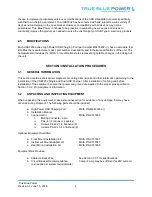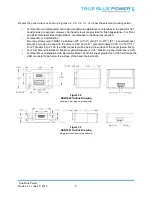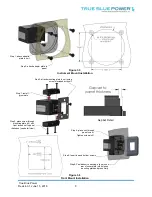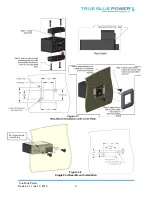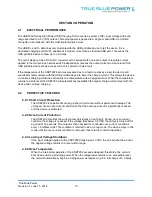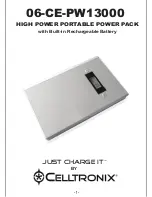
True Blue Power
Revision 1, June 15, 2018
3
1.2.4 Versions
Non Lighted
Lighted
Power Input
Location
USB Connector
M6430202-1
M6430202-11
Rear
Dual: Type A+Type C
M6430202-2
M6430202-12
Bottom
M6430202-3
M6430202-13
Rear
Dual: Type C+Type C
M6430202-4
M6430202-14
Bottom
M6430202-5
M6430202-15
Rear
Dual: Type A+Type A
M6430202-6
M6430202-16
Bottom
M6430202-7
M6430202-17
Rear
Single: Type C
M6430202-8
M6430202-18
Bottom
M6430202-9
M6430202-19
Rear
Single: Type A
M6430202-10
M6430202-20
Bottom
Table 1.4
SECTION 2 PRE-INSTALLATION CONSIDERATIONS
2.1
COOLING
No external cooling is required. The unit will become warm when in use. This is normal and within
operational parameters. No special mounting considerations are required; however, mounting to a metal
surface can help dissipate any heat generated and extend the life of the product.
2.2
EQUIPMENT LOCATION
The USBT202 High Power USB Charging Port is designed for mounting flexibility, allowing for installation
in the cockpit or in the cabin. It is designed for panel mounting and can be installed in a rectangular
configuration or, with an available installation kit, can be front mounted with a cosmetic cover plate. An
instrument mounting adapter bracket is also available to easily mount the unit in a standard 2.25 inch
round instrument opening that may already exist in the cockpit panel. There are two versions to choose
from which allow the input connector to be located either on the rear of the unit or from the bottom.
The unit can be mounted in any orientation. Clearance should be provided for the mating connector which
may require an additional inch beyond the rear of the unit.
2.3
ROUTING OF CABLES
Avoid sharp bends in cabling and routing near control cables. Avoid close proximity and contact with
vehicle structures, equipment or other obstructions that could chafe wires during operation and cause
undesirable effects.
2.4
LIMITATIONS
The USB Type-C interface is an exciting new connector for electronic devices. Beyond the physical format
of the Type-C connector, it also allows for a variety of interface options when communicating with
compatible devices. This device-to-charger communication is defined within the USB 3.1 Specification and
Power Delivery 2.0 standards. However, manufacturers of consumer electronic devices and/or cables may




